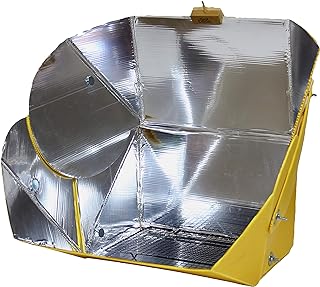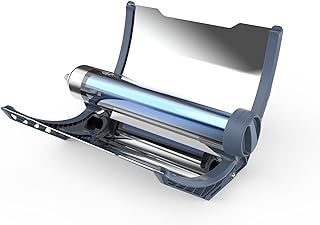Table of Contents
Ovens
Built-in Ovens
Since ovens are large and resource-hungry they are usually only found in more feature-rich van builds or RVs, schoolies, some truck campers, etc. They are only rarely found in cargo vans and class B RVs. The common R/V cutout size for 3-burner ovens is 21“ wide and 19” deep, so if you can fit that in your build you'll have plenty of options. Most run on low-pressure propane. Some options are here: https://pantherrvproducts.com/cooking/cooktop-oven-combos/
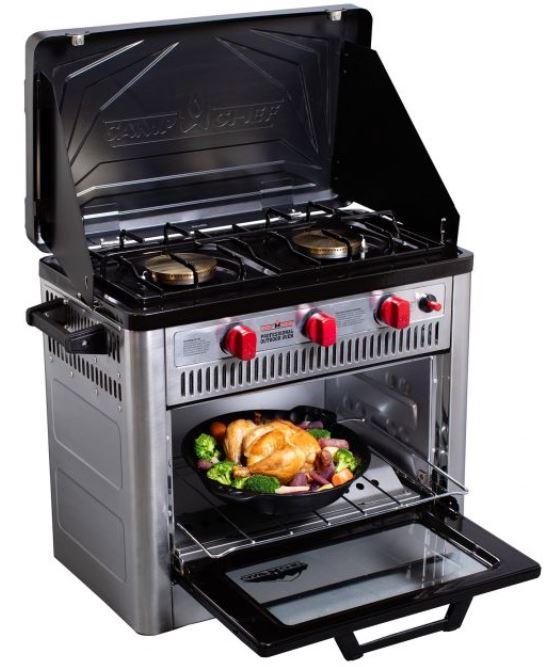 For those who do like having a real oven but need something smaller than the common RV size, the Camp Chef camping ovens have some popularity due to their relatively compact size at only 12“ deep and 20” wide (if you take the handles off). However because they are built to be lightweight and portable, they are extremely flimsy. They rattle and shake and buzz endlessly, no matter how smooth the road that you're driving on is. Long-term reliability is also questionable with the flimsiness of the construction, and they use a weird proprietary propane fitting that can be fiddly to adapt onto and sticks far off the back (making them need more depth than they should).
For those who do like having a real oven but need something smaller than the common RV size, the Camp Chef camping ovens have some popularity due to their relatively compact size at only 12“ deep and 20” wide (if you take the handles off). However because they are built to be lightweight and portable, they are extremely flimsy. They rattle and shake and buzz endlessly, no matter how smooth the road that you're driving on is. Long-term reliability is also questionable with the flimsiness of the construction, and they use a weird proprietary propane fitting that can be fiddly to adapt onto and sticks far off the back (making them need more depth than they should).
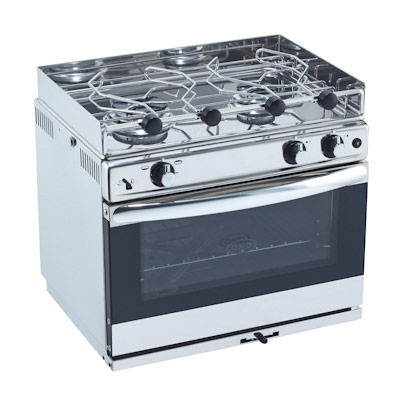 People who REALLY want an oven in a very small space have sometimes turned to boat ovens, which offer much better build quality in a very good form factor with a lot of features that do make them great for vans. But just like anything built for airplanes, anything built for boats carries a very high price tag. Ideally you'll look for a 2-burner version as they're generally shallower and the most compact, but don't say we didn't warn you about the prices.
People who REALLY want an oven in a very small space have sometimes turned to boat ovens, which offer much better build quality in a very good form factor with a lot of features that do make them great for vans. But just like anything built for airplanes, anything built for boats carries a very high price tag. Ideally you'll look for a 2-burner version as they're generally shallower and the most compact, but don't say we didn't warn you about the prices.
Solar ovens
Solar ovens are popular with boondockers in sunny areas because they require no power to operate. All they take is sun and time (both of which the boondocker may have in abundance).
Typical temperatures for commercial models are in the 250F range with a max of 300F. Higher and more consistent temps are possible when the box is enclosed with a clear cover that faces the sun.
There are also plans online for DIY solar ovens like the $5 oven.
Con: due to their surface area and low weight they do best when there is no wind.
BYOP type
Bring Your Own Pot solar ovens are generally either a rigid box type (left) or flexible pouch type (right). In either case the pot will be dark in color with a black or clear lid.
The box type is more traditional and may be more efficient. The pouch type may be the least efficient but stores flat and is effectively unbreakable.
DIY solar ovens tend to be the box type since they can be made from cardboard boxes lined with foil.
tube type
Higher temperatures and better results can be achieved with a tube-type cooker where the food is slid into a long clear tube. Cons: breakable, harder to clean and store.
further reading
Stovetop ovens
The Omnia oven is the most popular stovetop oven.
Folding ovens
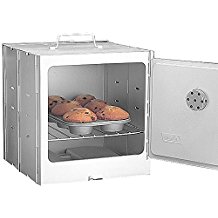 A folding oven is a stamped metal box that folds flat for storage and unfolds into a box for stovetop baking. The most famous example is the Coleman folding oven.
A folding oven is a stamped metal box that folds flat for storage and unfolds into a box for stovetop baking. The most famous example is the Coleman folding oven.
Most types have a built-in thermometer and rely on stove output to regulate temperature. Because of their small size and light weight it can be difficult to keep an even temperature; lower flames are easiest to adjust.
Pseudo-ovens
Although they are not actually ovens, dutch ovens and crockpots can be used for some kinds of baking.

